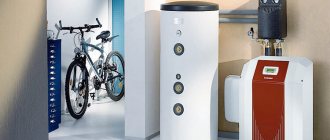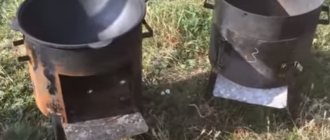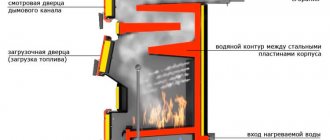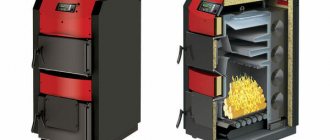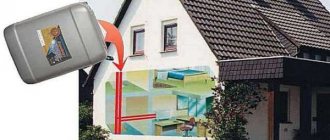Read: 206
What do many people associate with home comfort, warm evenings and a romantic atmosphere? For many, it's definitely all about having a fireplace. However, this is more an attribute of a private house, where it was initially written off in the layout of the house, like other utilities. But what if you need it in an apartment where there is neither a possible location for this, if we are talking about a traditional design, nor free space? The construction market today is ready to surprise with a variety of fireplace designs, but we are most attracted to the bio-fireplace as an excellent alternative to the classic design, which is easily suitable for furnishing apartments without the need to carry out complex repair work.
Let's figure out what types of biofireplaces there are, how they differ, and which models are considered the most practical. Let’s also not forget to look at the advantages and disadvantages of such fireplaces in order to understand who they will definitely suit and who should consider other options.
Buying guide - which biofireplace to buy?
If you can't install a traditional fireplace in your home, consider purchasing a biofireplace. It does not require connection to a ventilation system; room ventilation is sufficient. Don't know which bio-fireplace to choose? You will know everything after reading the buying guide.
Installation method
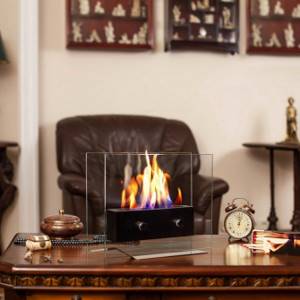
Based on the installation method, there are three types of biofireplaces: free-standing, hanging and built-in. The first, as the name suggests, can be placed anywhere, not necessarily next to a wall, and can also be moved from place to place. These types of biofireplaces are practical; among them you can find models that are small enough that you can even place them on a table.
They don't generate a lot of heat but are a great decoration. Hanging fireplaces are a little more difficult to install as they require drilling several holes in the wall. These models can be hung anywhere, they do not significantly limit the free space, so they are good for small spaces. Built-in biofireplaces resemble traditional ones. Often such models are suitable for installation in a corner.
Closed or open hearth?
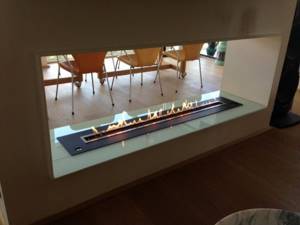
Biofireplaces come with closed and open fireplaces. It is true that glass can limit the amount of heat released into a room, but it is a safer solution in homes with small children and animals. In an open hearth, the flame is not shielded, and getting too close to it can lead to burns. When deciding which fireplace to buy, you should consider the safety of your household.
Material of execution
The material of biofireplaces is usually made of stainless steel, so it is resistant to corrosion. It is powder coated in a variety of colors so you can easily find a model that matches the rest of your interior fittings. The fireplace door should be equipped with heat-resistant glass that is resistant to breakage and easy to keep clean. There are also models with an MDF body and a ceramic front panel, which look no less elegant. The most important thing is that the biofireplace is not subject to mechanical damage.
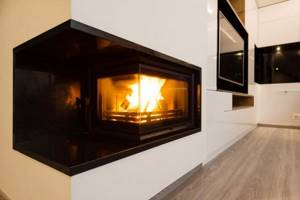
It is true that a biofireplace does not act as the main source of heat in the house, but after lighting a fire in the hearth, the room temperature usually rises by several degrees Celsius. The efficiency of a biofireplace depends on its thermal efficiency (expressed as a percentage) and heating power. In the case of smaller models, it will not be more than approximately 3000 W, but there are also much more powerful biofireplaces, more than 8000 W. Moreover, some allow you to adjust the heating power within a certain range, and this allows you to independently determine the efficiency of heating the room.
Dimensions and weight

By checking the overall dimensions of the bio-fireplace, you can make sure that you can install it in the previously chosen location. As a standard, the height of biofireplaces does not exceed 100 cm, as does the width. Their weight usually ranges from several to several tens of kilograms (but sometimes exceeds 100 kg). The heavier the model you choose, the more difficult it is to assemble it (often it is impossible to assemble it yourself).
Fuel
You need bioethanol to burn in a biofireplace. It can be in gel or liquid form. It is an odorless biofuel that, when burned, turns into water vapor and a small amount of carbon dioxide. Liquid bioethanol is sold in bottles ranging from 1 to 5 liters, and gel is sold in canisters, usually about 0.5 liters. How much fuel you will use primarily depends on the size of the flame and the capacity of the bio-charger. Sometimes it is 0.2 liters, and sometimes much more, even 2 liters. On average, one liter of bioethanol is enough for at least 1 and maximum 6 hours of combustion.
Safety

If the biofireplace is used in accordance with the manufacturer's recommendations, you do not need to worry about your own safety and the safety of other household members. Care must be taken, especially when adding biofuel to the stove. It is recommended to fill no more than 50% of the biocharging capacity; this will prevent accidental spillage of bioethanol. It is also important not to add fuel while the stove is still hot, as it may explode. The best bio-fireplace has a special funnel, which makes pouring bioethanol much easier.
Design
Some biofireplaces look modern, while others fit well into a classic interior. They are all varied in design, so everyone will surely find something to their liking. Very often, accessories are attached to a biofireplace that add elegance to it. This could be, for example, decorative stones for the hearth or ceramic logs that imitate wood.
Biofireplaces at good prices

For a small bio-fireplace that can be placed on a shelf or table, you will pay no more than 18,000 rubles. If you are interested in a much larger bio-fireplace, you should prepare to spend up to 35,000 rubles. Factors that influence the price of this type of product are primarily: brand, material, size and design.
Without which the device cannot operate – 4 main blocks
You cannot make a beautiful and reliable eco-fireplace without understanding its structure. It is not complicated - there are only four blocks. The entire system is based on a fuel tank - the service life and safety of the structure depend on it. The dimensions of the fuel tank also depend on the dimensions of the fireplace. It is recommended to use containers made of materials that are resistant to corrosion and chemically active elements (stainless steel, ceramics).
The burner is sometimes considered an integral part of the fuel tank. In fact, this is a separate module that can be purchased in the store. However, it is also possible to make such a thing - a burner for a bio-fireplace with your own hands. The design is simple - a fine-mesh metal mesh into which filler impregnated with fuel is placed. Mineral wool or ceramic fabric is used as filler. The dimensions of the burner must correspond to the perimeter of the tank - it serves as its lid.
The wick is needed to ignite the burner. To do this, one end of it is lowered into a tank with fuel, and the other lies on the mesh burner and is masked with artificial firewood or coals. The cost of the finished wick is low, and it can be bought in the store. However, production will not take much time. Essentially, a rope twisted from cotton fabric can be used to light a fireplace.
The overall interior of the room depends on the fireplace portal. For classic fireplaces, they are made of stone (marble, travertine, shell rock) or brick. Sometimes you can find a bio-fireplace framed by stone. But we also have more affordable materials at our disposal (artificial or natural stone, glass, metal, brick, drywall).
FAQ
Q1: Does the bio-fireplace provide heat?
Biofireplaces are usually considered mainly as an elegant decorative element of the interior. However, it turns out that they can also heat the room and thereby increase the comfort of staying in it. It is true that bio-models are not as efficient as traditional fireplaces, but they are ideal for small spaces and those where there is no proper chimney installation.

Q2: Biofireplace - how does it work?
The biofireplace does not require constant addition of firewood, pellets or coal. It runs on bioethanol. This is a special type of alcohol-based fuel that can be in the form of a gel or liquid. The biofireplace does not emit odor or smoke; it requires oxygen to operate. Almost 100% of biofuel is burned, and the resulting thermal energy is completely released into the environment.
Floor-standing “aquarium” for live fire – how to make it?
The floor biofireplace is most popular among craftsmen. This is easily explained by its features - it can imitate a classic wood-burning fireplace or, on the contrary, act as a futuristic element of the interior. When starting work, prepare the necessary materials in advance: thick glass or heat-resistant glass ceramics, silicone sealant, a flowerpot made of wood or metal, two tanks for liquid fuel, a heat insulator, a burner, a wick. The appearance of the future fireplace depends on the size and shape of the flowerpot.
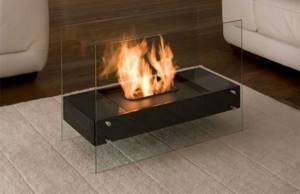
Floor biofireplace is most popular among craftsmen
In fact, assembling the biofireplace modules into a single whole is not difficult. The main problem is in their manufacture. At the heart of the fireplace-aquarium is a flowerpot. You can make it yourself from wood or choose a metal box. Wooden products must be treated with fire-fighting solutions. The next element is a protective glass cube. It is to him that the fireplace owes its name “aquarium”. For assembly you will need silicone sealant, glass or glass ceramics.
You need to prepare four sheets of glass/glass ceramics. Their width depends on the dimensions of the flowerpot, and their height rarely exceeds 50 cm. Please note! The finished product must be installed in a flowerpot and adjacent to the inner surface of its walls. To assemble the “aquarium”, coat the vertical edges of the glass blank sheets with sealant and connect them into a cube. Allow the sealant to dry (24 hours), then cut off any excess.
The fuel tank of the “aquarium” is assembled from two containers of different sizes. The smaller one is a fuel tank, which is installed in the larger one for safety reasons. By the way, the collected container should be 2-3 cm below the walls of the flowerpot. For safety reasons, wrap the tanks with Isover or asbestos cloth. The wick and gas burner are made in the same way as for a tabletop fireplace. The only difference is in size.

We place a lid on top of the tank - a burner made of metal mesh and filler
After all the components of the future “aquarium” are ready, we begin to assemble them into a single whole:
- Coat the inner surface of the walls of the flowerpot with sealant and lower the glass cube into it.
- Lower the prepared double-circuit fuel tank into the center of the flowerpot.
- On top of the tank we place a lid - a burner made of metal mesh and filler (cotton wool).
- The final stage is the decorations. We lay out decorative coals and firewood along the grid, among which we hide the wick lowered into the fuel tank.
The fire cube will decorate the interior of any room. Sometimes such a fireplace is made mobile. For this purpose, the flowerpot base is equipped with wheels.
Biofireplace - what is it?
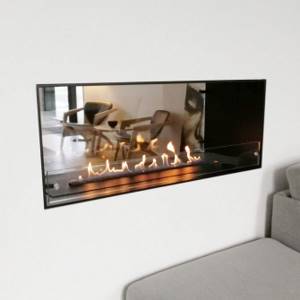
Biofireplace is a beautiful interior decoration, but not everyone has the opportunity to install it at home, especially in an apartment in an apartment building. For this reason, biofireplaces that do not require, for example, pipes for exhaust gases, are becoming increasingly popular. Below we will explain what a biofireplace is and how it works.
What is a biofireplace?
A biofireplace is a special type of fireplace that is powered by a special biofuel, rather than wood and coal. This makes it possible to install it in any room of the house without the need for extensive installation. It is enough to make sure that the room is well ventilated. Biofuel, or bioethanol, comes in liquid and gel form and burns almost 100%. The combustion process produces small amounts of water vapor and carbon dioxide. To get rid of them, it is enough to regularly ventilate the room. Oxygen is necessary for the bio-fireplace to function properly, so sometimes it is necessary to open the windows.
Types and diagrams of burners
As for the description of the burners, they can be of several types and have different characteristics, but they all operate on the general principle, evaporative atmospheric. That is, the fuel evaporates in a heated chamber in the absence of air, and the vapors released into the atmosphere burn in the air.
For this operating principle, there are three types of burners:
- capillary,
- wick,
- gravity flow.
The capillary burner has a simple design, but there are a number of disadvantages. When starting up, you may smell ethanol; the filler in the burner tank becomes clogged over time and requires replacement, and it is also necessary to provide a barrier and adjust the flame height, since at the beginning of operation the fire burns hotter.
The wick burner is easier to use. Filling the container with fuel is done “by eye”. The flame of this type of burner is stable, without sudden changes, so a barrier is not required, except for various flame effects, but it is worth providing for the presence of a divider grille.
A gravity burner produces a stable flame during operation and does not emit vapors when warming up, since a supply of them is formed in the evaporator and this is enough to start. In addition, this type of burner can be produced in a round shape, provides long operation, up to 4 hours, and is also suitable for a fireplace of any power.

Is biofireplace safe?

If you follow a few basic rules, the bio-fireplace will definitely not threaten the safety of your household. In addition to ventilating the room, it is also important to be careful when adding fuel to the firebox. Bioethanol can only be added when the fireplace is extinguished and cooled down. If the fire has already gone out and you want to relight it, you must wait until the fire goes out. Otherwise, when adding biofuel, you may get burned or cause a fire due to the unexpected explosion of flammable vapors. If bioethanol spills, you should wipe it up before lighting the fireplace.
To avoid putting yourself and your loved ones at risk, you should also choose good quality biofuel and store it properly. In particular, it is not recommended to purchase bioethanol that is not intended for combustion in a fireplace. This soot-producing mixture of ethanol and gasoline can also explode suddenly. Because biofuel is a flammable liquid, we must store it away from sources of fire and out of the reach of children and pets.
Design and configuration of biofuel fireplaces
The designs of biofireplaces include a special tank or container into which fuel is poured. Some models may be equipped with burners and nozzles. The design of such fires also often includes a special damper, with the help of which the supply of oxygen to combustion is abruptly stopped and the fire goes out. Ignition or extinguishing of the flame in these fireplaces occurs very quickly.

To ensure maximum safety and practicality, many models of biofoci are equipped with special technical solutions. For example, special protection for the fuel tank, which prevents fuel from spilling out in the event of an unexpected overturning of the product. Many models in a higher price category are equipped with automation and sensors that monitor all operating and combustion processes in the hearth. Automation is also capable of abruptly stopping the operation of the fireplace in the event of an accident or incorrect operation of the product systems.
The main design of biofoci consists of:
- Fuel block (alcohol tank and burner)
- Main building
- decorative body (portal, cladding)
Depending on the model, configuration, dimensions and class, the biofireplace package may also include:
- automatic control system or unit (ignition and extinguishing, safety control, change of combustion modes, flame intensity and temperature level)
- unit and remote control at a distance
- audio module for simulating the sound of a burning fire and crackling wood
- steam generator to simulate smoke
- LED backlight to enhance the visual component of the flame
- decorative elements in the firebox (imitation firewood, etc.)
A decorative body—the lining of the fireplaces—can be considered a separate structural element. As a rule, it is this moment that is responsible for the design execution of the product, making it an independent and very advantageous participant in the interior.
What are biofireplaces made of?
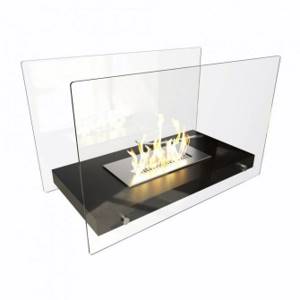
Several different materials are used to produce biofireplaces. The most common are glass, stainless steel, concrete, stone and MDF. This affects not only the appearance of the product, but also its durability. Many people do not know which biofireplace is recommended for reliability. The main thing is to choose a model with a heat-resistant case. Although it does not have direct contact with the fireplace, it should be designed to allow the fireplace to be used safely.
What are the advantages and disadvantages of biofireplaces?
As already mentioned, it is suitable for installation both in a house and in an apartment. In addition, there are many products that cost less than 10,000 rubles, so buying a biofireplace should not burden your home budget. This is an original interior decoration, and the fire in the hearth adds coziness and a unique atmosphere to the room.
We should not forget that biofuel is environmentally friendly. However, biofireplaces are not without their drawbacks. They do not work well as the main source of heat in the home because their heating output is too low. In addition, regular ventilation of the room can become unpleasant, especially on frosty days and evenings. However, this is necessary for your safety.
